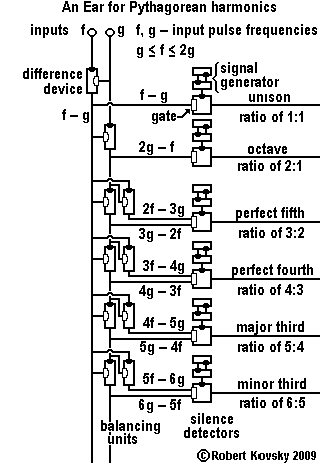
This page was the original referral for the technical paper, "An Ear for Pythagorean Harmonics: Brain Models Built From Timing Devices," a .pdf file that continues to be available for download ( ... ) here and through the new pages. The paper has been only minimally revised; it contains materials not otherwise available but other materials in it have been superseded.
2/4/11 The original web page is reproduced below:
|
An Ear for Pythagorean harmonics is a device design that shows how timing devices can model brains and imitate brain functions. If two input signals f and g, "pure tones" musically, are in a relationship that is known as a "Pythagorean harmonic" (octave, perfect fifth, major third, etc.), the Ear detects the relationship and a signal appears on the output line bearing the name of the harmonic. A frequency combination shown on an internal line, e.g., |

|
|
Your comments and suggestions are welcome. Please write to the adjacent email address (shown in an image to minimize spam). |

|
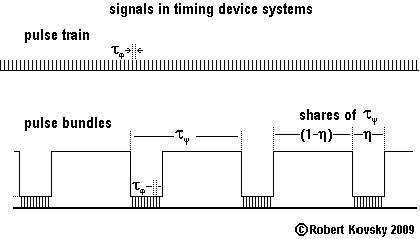
| The two chief types of signals in timing device systems are shown in the adjacent image: uniform pulse train and pulse bundles. Pulse bundles resemble "bursts of action potentials" seen in nerves. |
| Some timing devices operate with pulse trains and other timing devices operate with pulse bundles. Certain timing devices convert signals from one form to another. The adjacent image shows three examples of conversion. The top two images show inputs and outputs of two kinds of "streaming devices" and the bottom image shows inputs and output of a "pulse bundle generator." (Please see Figures 26, 28 and 29, respectively, in the formal Timing Devices paper.) |

|
| The primal timing device has a "response clock" that is like a stopwatch used in sports contests, shown in Figure 1.a as a circular clock dial. Two projections connect the primal timing device to other timing devices and a junction connects the "projection onto" to the response clock. A pulse arriving at the junction through the projection onto starts the "response process," which runs through a cycle of conditions, during which the primal timing device discharges a pulse through the "projection from." As shown in Fig. 1.b, a primal timing device has a "ready condition," a "responding condition" and a "refractory condition." The device responds to an arriving input pulse only when it is in the ready condition. Suppose an input pulse reaches a ready device at time t = 0, initiating the response process. The response clock starts and the device enters into the responding condition. At t = δ, the device discharges an output pulse through the projection from; and the device enters into the refractory condition, which continues until t = δ + β, when the device enters into the ready condition, completing the response process. |
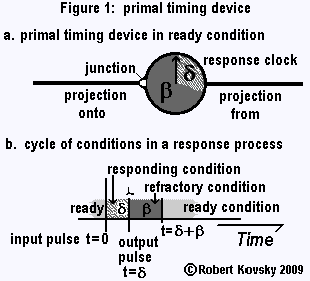
|
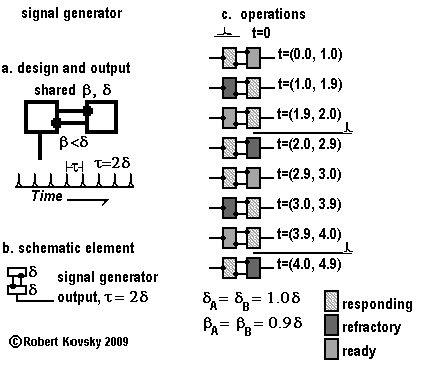
| Two inter-connected primal timing devices function as a signal generator, as shown in the adjacent images. Image a shows the design and output of the signal generator. The design resembles that of a multivibrator in standard electronic circuits. Image b shows a schematic element that is used in the design of the Ear for Pythagorean harmonics. Image c shows the signal generator in operation. An initiating pulse arrives at time t=0. Thereafter, the assembly goes through changes in an orderly way, represented by a sequence of momentary images, like frames in a video. Conditions of timing devices last for a specified period of time stated as t=(a, b) in each momentary image. In the idealized operations of timing devices, conditions change instantaneously. The images show conditions "before" and "after" each change; but the changes themselves are not shown. However, the discharging of pulses is pictured as taking place during changes that occur at t=2δ and t=4δ. |
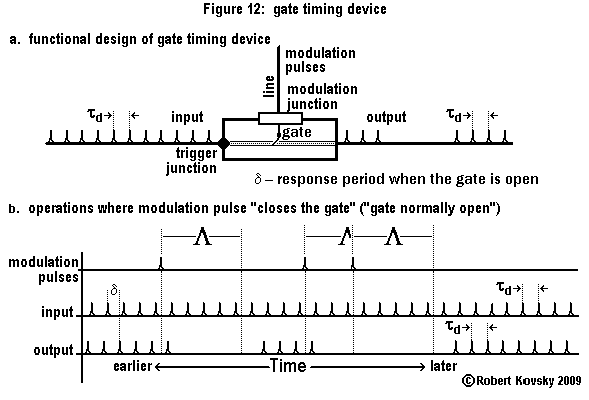
| Figure 13.a shows the design for the silence detector that is used in the Ear for Pythagorean harmonics. The silence detector is assembled from a signal generator and a normally-open gate timing device. In the silence detector, the normal condition of the gate corresponds to silence on the line to the gate. When there is silence on the line to the gate, the gate is open and the signal from the signal generator passes through to the output. On the other hand, when pulses arrive regularly through the line onto the modulation junction of the gate, the gate will stay closed. In brief: a signal on the line means a silent output. Silence on the line means that a signal appears as the output. |
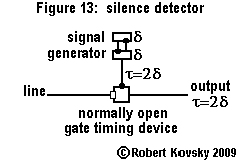
|
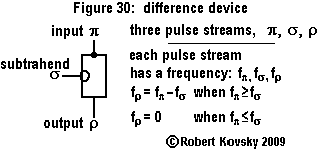
|
Figure 30 shows the design element for the difference device and its operations as a frequency subtraction device.
There are three signals: pulse streams π, σ and ρ. Pulse stream π is the input to the difference device. Pulse stream σ - called the "subtrahend" - resembles the stream of modulation pulses to the gate timing device but with somewhat different effect. Here, each pulse in the subtrahend stream cancels one pulse from the input stream. Pulse stream ρ is the resulting output stream.
Operations require that regular pulse streams arrive through the input and subtrahend lines. A regular pulse stream need not be perfectly uniform if it is repetitive with a definite period, however long, and if irregularities are smoothly distributed. These requirements are met for all operations of the Ear for Pythagorean harmonics, provided the input signals change slowly enough.
A frequency is defined for the regular pulse streams and the following relations describe the operations of the device.
|
|
Figure 31 shows an important use of the difference device, in two versions of "balancing units." In each version, two difference devices are hooked up to two pulse streams (f and g) that serve as input and subtrahend, one each to each difference device. For two regular pulse streams, one difference device will operate at any given moment and one output line will carry a signal; the other difference device will be silent. If the two pulse streams are identical (or nearly so), both lines will be silent.
Figure 31.a shows a balancing unit with separate outputs.
In the balancing unit shown in Figure 31.b, the outputs from the two difference devices are inputs to a simple timing device. At any moment in controlled operations, no more than one difference device generates input to the simple timing device. The possibilities are combined in the formulation |
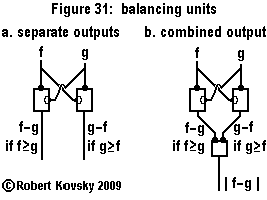
|
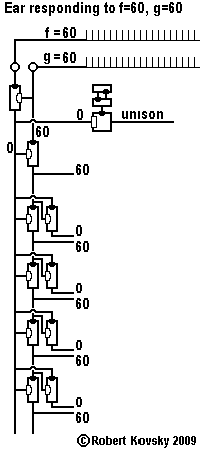
|
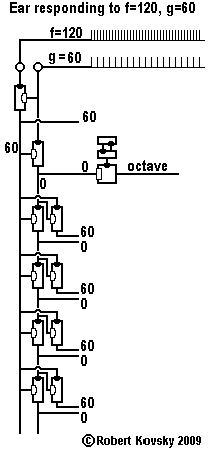
|
The adjacent images show the Ear operating at the limit points of its range of operations. At one limit point of the range of operations, when f=60 and g=60 and the two inputs are "in unison," the Ear detects that fact and a signal appears on the "unison" output line but on no other output line. The image for f=60, g=60 shows only the single silence detector where the gate is open. Its modulation line is silent; the frequency of the signal to the modulation junction is 0. The other image shows operations at the limit point that is the polar opposite of the first, that is, when f=120 and g=60 and the relationship is "octave." Again, that fact is similarly detected and a signal appears on the "octave" output line but on no other output line. In each image, the frequencies of the paired outputs of the balancing units at levels below the octave all have the same values. The frequencies of those paired outputs when the inputs are f=60, g=60 are reversed from the pairs when the inputs are f=120, g=60. As f traverses its range, moving from 60 to 120, the paired frequencies shift in an orderly but complex fashion from one extreme to the other. |
|
The adjacent images show operations of the Ear at intermediate points in its range of operations. When f=90, g=60, the relationship between the input tones is that of a "perfect fifth," as detected by the Ear. Both inputs to the perfect fifth silence detector are silent. The ratio is |
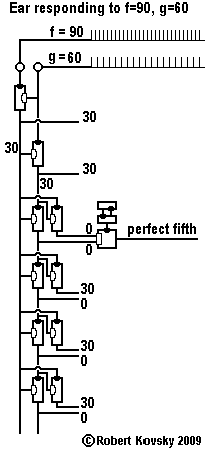
|
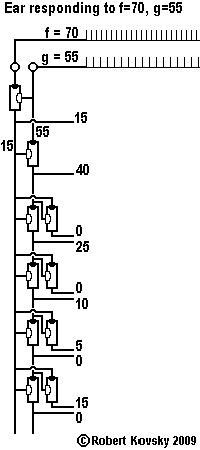
|
|
Celebrating nephew Steve's birthday.
 An example of "family resemblances."
| Robert Kovsky. B.S.E.E., MIT, 1968, Tau Beta Pi. M.A., Physics/Materials Science, UC Berkeley, 1971. J.D., UC Berkeley, 1974. I am an amateur in brain science, without institutional affiliation, grateful for the Internet as a publishing medium. My employment as an attorney includes recent representation of BitTorrent developers in copyright litigation adverse to Movie Studios (link to .pdf file at Electronic Frontier Foundation -- 789 kB.) and in privacy litigation adverse to the Motion Picture Association of America (MPAA) (link to .pdf file at Electronic Privacy Information Center -- 832 kB). |
|
Your comments and suggestions are welcome. Please write to the adjacent email address (shown in an image to minimize spam). |

|
(return to top of page).
- Quad Nets (2006)-- Quad Nets is the chief engineering and scientific presentation of my "device models of brains." Timing Devices, discussed here, began as a simplified version of the Quad Net model.
- Quad Nets website -- separately organized web page on the full paper titled Quad Nets: Material Foundations for Thermal Device Models of Brains download Quad Nets paper. (.pdf format, 1.1 Mb)
- Timing Devices (2007-2009) has developed from a simplified version of the Quad Nets Model into an independent area of investigation. The course of development includes possible future projects.
- The complete technical paper ("An Ear for Pythagorean Harmonics: Brain Models Built From Timing Devices") is available for download, a .pdf file, 460 kB. Another web page presents the Abstract of the paper and the listing of Contents. UPDATE: New publication May, 2010: (web page ...) Fundamentals of Timing Devices is a reconstruction of the timing devices system starting from first principles. The intent is to establish a solid foundation for later development. Some materials in An Ear for Pythagorean Harmonics have been superseded. The separate website, link, Shimmering Silences in Beautiful Music (2009) presented initial investigations and original constructions that developed into the present Ear for Pythagorean Harmonics, along with an earlier version of the Timing Devices paper, An Ear for Pythagorean Harmonics: Mathematical Processing in Brain Models Built From "Timing Devices," (2009), a .pdf file 212 kB. The separate web page, "Timing Devices or Why Brains Are Not Computers, link, is now the setting for the first, 2007, version of the Timing Devices paper, .pdf file, 363 kB. The separate web page, Dancer - Shimmering Gaits of a Six-Legged Engineered Organism link, contains a proposed series of projects for construction of systems for engineered organisms (artificial animals) to be built from timing devices and Quad Net assemblies, starting with a "Utricle" that detects the orientation of an organism with respect to gravity and progressively leading upwards to a six-legged organism that uses a variety of coordination patterns ("gaits") in attempts to navigate a broken and obstructed terrain. See also "Advanced Note: Convolution Timing Devices," a .pdf file (68 kB) link, preparatory for the present Timing Devices paper.
- Philosophy of Science. Please see A Patchwork of Limits: Physics Viewed From an Indirect Approach (2000), a .pdf file (157 kB) discussed on a separate web page The paper is a statement of my "alternative view of physics" that includes technical analysis of the thermodynamic critical state, the conceptual basis of Quad Nets. Please see also "On Cosmological Principles in Natural Science," a .pdf file (23 kB), link, suggestive of future approaches.